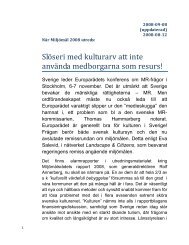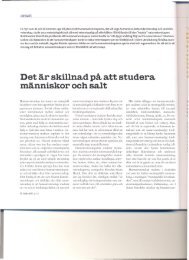Landscape through literature Le paysage à travers la littérature
Landscape through literature Le paysage à travers la littérature
Landscape through literature Le paysage à travers la littérature
You also want an ePaper? Increase the reach of your titles
YUMPU automatically turns print PDFs into web optimized ePapers that Google loves.
A year in the Austrian Nature Reserve<br />
“Wengermoor am Wallersee”<br />
In January, both ground and air are frosty. Yellow and<br />
brittle, rise the dying split-cottongrass b<strong>la</strong>des from the<br />
snow and as a habitat of insect <strong>la</strong>rvae they can be seen<br />
before they emerge in Spring. In the meantime the<br />
bullfinches call out from the moor<strong>la</strong>nd firs, otherwise<br />
it’s silent…<br />
No sooner is the <strong>la</strong>st snow and ice transformed into mist<br />
when many green buds start to bloom <strong>through</strong> the f<strong>la</strong>ttened<br />
winter straw of the peat bog’s small hills. Their<br />
light green covers the bog in May. The <strong>la</strong>st frost melts<br />
from the water-filled bog pools, the sphagnum moss feels<br />
soft and soapy again. The Birch trees’ and the Alder<br />
Buckthorns’ buds stretch and burst out of the edges of<br />
the bog and in old peaty ditches. Spring winds sweep<br />
yellow clouds of pollen over the bog with its still, b<strong>la</strong>ck<br />
surface of pool water…<br />
The July heat weighs heavily on the bog, not one Aspen<br />
leaf flutters in the treetops of the edge of the woods.<br />
The heavy air shimmers in harmony with the chirps of<br />
all the crickets, grasshoppers and cicadas. After long<br />
<strong>la</strong>sting sultriness winds bring the warm and dusty air from<br />
the fields but thunder rumbles already. Minutes after<br />
gusts come breezing. The first lightening strike arrives<br />
with heavy drops which on impact and together with the<br />
wind make the leaves move. In the bog the rustling of<br />
the adders was stopped in the heather. Finally it pours<br />
so heavily that no <strong>la</strong>ndscape is visible any longer, only<br />
shapeless grey wetness. Glistening <strong>la</strong>ndscape will though<br />
be in the evening and it will smell of rain…<br />
Not a breath of air disturbs the <strong>la</strong>ke, the stiff yellow reed<br />
standing silently, no longer rustling and swaying in<br />
shaky circles like they do in the summer wind. The fish<br />
rarely jump as such leaps are only worthwhile for the<br />
insects which are now rarely seen flying over the <strong>la</strong>ke.<br />
Heather blossoms crumble under foot. Small yellow<br />
specks on the ground are the first signs of October and<br />
the leaves have fulfilled their prior purpose. … Waveless<br />
water slowly carries the leaves along. The day’s end<br />
paints powerful colours, creating strong lines and puts<br />
b<strong>la</strong>ck shadows over the bog.<br />
November sunlight reflects little warmth off the water’s<br />
surface. … In early morning a fine membrane forms on<br />
the water. The flowing streamlets can no longer be<br />
heard. The leaves have time to sink and will turn to<br />
peat. The view finds its way again <strong>through</strong> the branches,<br />
the treetops show skeleton shadows. The evening gets<br />
closer, a far away mountain stands grey in the <strong>la</strong>st<br />
light. The sun, underneath the horizon, reddens the<br />
small clouds for precious moments far too short.<br />
A first cold Winter wind has spread small dunes of<br />
powder snow upon weak pool ice. The bog has turned<br />
towards a Winter’s night, away from the red sky to<br />
silent b<strong>la</strong>ck hours of the advent. With cold feet I wander<br />
silently away leaving the bog.<br />
Trans<strong>la</strong>tion: Berlitz, adapted by Gertrude Friese.<br />
Une année dans une réserve<br />
naturelle autrichienne<br />
«Wengermoor am Wallersee»<br />
En janvier, air et terre sont gelés. Jaunes et fragiles, les<br />
brins de coton éc<strong>la</strong>tés jaillissent de <strong>la</strong> neige et, tels<br />
l’habitacle d’une <strong>la</strong>rve d’insecte, on les voit qui pointent<br />
au printemps. Hormis le cri du bouvreuil dans les<br />
sapins de <strong>la</strong> <strong>la</strong>nde, c’est le silence. […]<br />
A peine les dernières neiges et g<strong>la</strong>ces transformées en<br />
brume, une myriade de bourgeons verts commence <strong>à</strong><br />
fleurir sur l’herbe desséchée des collines. En mai, leur<br />
vert c<strong>la</strong>ir tapisse <strong>la</strong> tourbière. <strong>Le</strong>s dernières gelées<br />
fondent dans les mares remplies d’eau, <strong>la</strong> mousse des<br />
marais retrouve son moelleux. <strong>Le</strong>s bourgeons des<br />
bouleaux et des aulnes pointent sur les bords du marais<br />
et dans les vieux fossés tourbeux. <strong>Le</strong>s vents printaniers<br />
ba<strong>la</strong>ient des nuages jaunes de pollen sur les mares<br />
noirâtres de <strong>la</strong> tourbière. […]<br />
La chaleur de juillet pèse lourdement sur <strong>la</strong> tourbière<br />
et, au faîte des trembles qui bordent les bois, pas une<br />
feuille ne frémit. L’air alourdi palpite en harmonie avec<br />
les gazouillements des criquets, des sauterelles et des<br />
cigales. Après une longue touffeur, les vents apportent<br />
l’air chaud et poussiéreux des champs, mais le<br />
tonnerre gronde déj<strong>à</strong>. Encore quelques minutes et <strong>la</strong><br />
brise vient par bouffées. <strong>Le</strong> premier éc<strong>la</strong>ir arrive, chargé<br />
de grosses gouttes qui, avec le vent, agitent les feuilles.<br />
Dans <strong>la</strong> bruyère, le bruissement des vipères s’est arrêté.<br />
Enfin, <strong>la</strong> pluie s’abat si lourdement que le <strong>paysage</strong><br />
disparaît; ne reste qu’un ruissellement gris et informe.<br />
Avec le soir, le <strong>paysage</strong> étince<strong>la</strong>nt se charge d’une<br />
odeur de pluie. […]<br />
Pas un souffle d’air ne trouble le <strong>la</strong>c, les roseaux jaunes<br />
se dressent en silence; plus un bruissement, plus de<br />
ba<strong>la</strong>ncement en cercles frémissants sous le vent de l’été.<br />
<strong>Le</strong>s poissons bondissent rarement hors de l’eau; plus<br />
<strong>la</strong> peine, les insectes sont rares, <strong>à</strong> présent, <strong>à</strong> voleter sur<br />
le <strong>la</strong>c. <strong>Le</strong>s bouquets de bruyère craquent sous le pied.<br />
De petites taches jaunes jonchent le sol, premiers signes<br />
d’octobre, et les feuilles ont fini de jouer leur rôle<br />
premier. […] <strong>Le</strong>s eaux immobiles charrient les feuilles.<br />
La fin du jour jette des couleurs f<strong>la</strong>mboyantes, dessinant<br />
des lignes nettes et des ombres noires sur les<br />
marais.<br />
La lumière du soleil, en novembre, capte peu de chaleur<br />
de <strong>la</strong> surface de l’eau. […] Tôt le matin, une fine<br />
membrane se forme sur l’eau. On n’entend plus couler<br />
les ruisseaux. <strong>Le</strong>s feuilles prennent leur temps pour<br />
sombrer et devenir tourbe. Enfin, les arbres <strong>la</strong>issent <strong>à</strong><br />
nouveau passer le regard; ils accrochent des ombres<br />
squelettiques dans leurs plus hautes branches. <strong>Le</strong> soir<br />
se rapproche; dans le lointain, une montagne dresse<br />
sa silhouette grise dans <strong>la</strong> lumière finissante. <strong>Le</strong> soleil,<br />
plus bas que l’horizon, rougit les petits nuages pour<br />
quelques instants précieux bien trop brefs.<br />
Un premier vent froid d’hiver a éparpillé de petites<br />
dunes de neige poudreuse sur <strong>la</strong> g<strong>la</strong>ce fine des mares.<br />
La tourbière est entrée dans une nuit hivernale, dé<strong>la</strong>issant<br />
le ciel rouge pour vivre les heures noires et muettes<br />
de l’Avent. <strong>Le</strong>s pieds froids, je m’éloigne doucement,<br />
en silence, de <strong>la</strong> tourbière.<br />
Traduction: Conseil de l’Europe, 2005.<br />
n a t u r o p a n o 1 0 3 / 2 0 0 5 9





